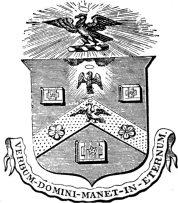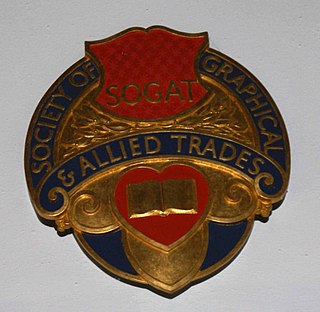Related Research Articles
In British politics, an affiliated trade union is one that is linked to the Labour Party. The party was created by the trade unions and socialist societies in 1900 as the Labour Representation Committee and the unions have retained close institutional links with it.

The Worshipful Company of Stationers and Newspaper Makers, usually known as the Stationers' Company, is one of the livery companies of the City of London. The Stationers' Company was formed in 1403; it received a royal charter in 1557. It held a monopoly over the publishing industry and was officially responsible for setting and enforcing regulations until the enactment of the Statute of Anne, also known as the Copyright Act 1710. Once the company received its charter, "the company's role was to regulate and discipline the industry, define proper conduct and maintain its own corporate privileges."

The Society of Graphical and Allied Trades (SOGAT) was a British trade union in the printing industry.
The International Typographical Union (ITU) was a North American trade union for the printing trade of newspapers and other media. It was founded on May 3, 1852, in the United States as the National Typographical Union. It changed its name to the International Typographical Union at its Albany, New York, convention in 1869 after it began organizing members in Canada. The ITU was one of the first unions to admit female members, admitting women members such as Augusta Lewis, Mary Moore and Eva Howard in 1869.

The National Union of Printing, Bookbinding and Paper Workers (NUPBPW) was a British trade union.
The National Union of General Workers (NUGW) was an early general union in the United Kingdom, the most important general union of its era.
The National Amalgamated Union of Labour (NAUL) was a general union in the United Kingdom.
The Printing Industry Employees' Union of Australia (PIEUA) was an Australian trade union which existed between 1915 and 1966. It represented a range of production and trades workers in the printing industry.
The National Amalgamated Union of Shop Assistants, Warehousemen and Clerks was a trade union representing retail workers in the United Kingdom.
The Amalgamated Textile Warehousemen's Association was a trade union representing workers in the textile industry in the United Kingdom, principally in Lancashire.
The General Council of the Trades Union Congress is an elected body which is responsible for carrying out the policies agreed at the annual British Trade Union Congresses (TUC).

The Amalgamated Society of Dyers, Finishers and Kindred Trades was a trade union representing dyers and workers in related jobs in the United Kingdom.
The National Union of Wallcoverings, Decorative and Allied Trades (NUWDAT) was an industrial union representing workers connected with the manufacture of wallpaper in the United Kingdom.

The Printing and Kindred Trades Federation (P&KTF) was a trade union federation in the United Kingdom.
The National Union of Printing and Paper Workers was a trade union representing workers in the printing industry in the United Kingdom.
Alfred Evans was a British trade union organiser.
The United Society of Engravers was a trade union representing engravers, principally in the cotton industry, but also in the paper printing industry, in the United Kingdom.
Thomas George Newland was a British trade union leader.
The National Society of Electrotypers and Stereotypers (NSES) was a trade union representing workers in print foundries in the United Kingdom.
The National Union of Paper Mill Workers (NUPMW) was a trade union representing labourers in paper mills in the United Kingdom.
References
- ↑ https://archiveshub.jisc.ac.uk/search/archives/b36ae9d7-77c2-3729-8bff-767a4ec8ef75
- 1 2 3 Arthur Marsh and John B. Smethurst, Historical Directory of Trade Unions, vol.5, p.50
- 1 2 3 Bundock, Clement (1959). The Story of the National Union of Printing, Bookbinding and Paper Workers . Oxford: Oxford University Press.